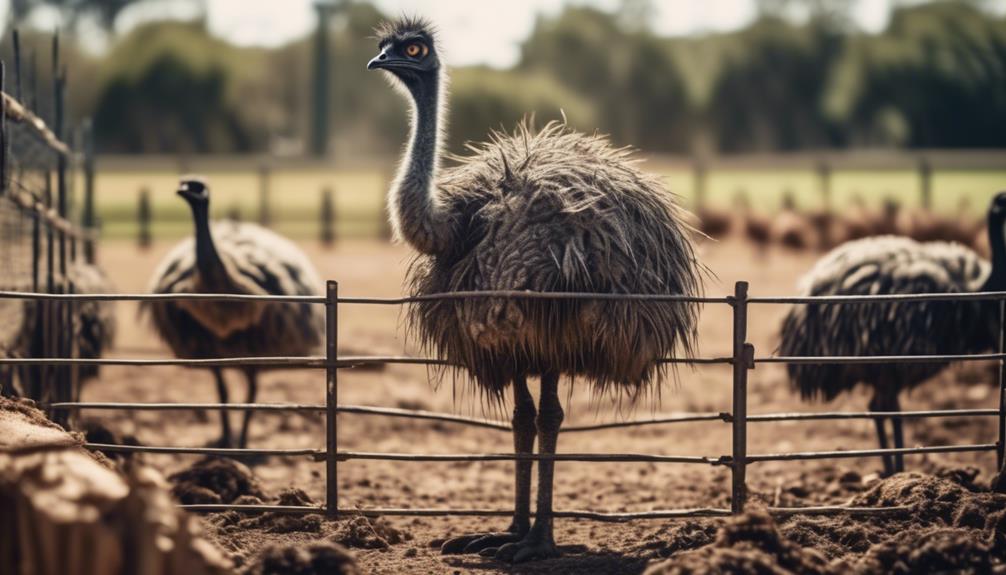
Did you know that emu farming can have a significant economic impact? The industry may not be as well-known as other agricultural sectors, but it is gaining recognition for its potential to create jobs, stimulate local economies, and generate revenue.
In this detailed overview, we will explore the various aspects of emu farming that contribute to its economic significance. From the growth of the industry to the market demand for emu products, we will delve into the financial implications, challenges, and future opportunities that await those involved in this unique sector.
So, let's take a closer look at the economic impact of emu farming and discover what makes it a promising venture worth exploring.
The Growth of Emu Farming

The growth of emu farming has been steadily increasing over the past decade, driven by a combination of factors such as rising consumer demand for emu products and the potential profitability of the industry. Emus, native to Australia, have gained popularity in various parts of the world due to their low-fat, high-protein meat, as well as the market potential for their oil and feathers.
Emu farming offers significant growth potential, with industry trends pointing towards a positive outlook. According to market research, the global emu farming market is projected to grow at a CAGR of 6.8% from 2021 to 2026. This growth can be attributed to the increasing awareness of the nutritional benefits of emu products, which has led to a rise in consumer demand. Additionally, emu oil is gaining traction in the cosmetic and pharmaceutical industries, further driving the growth of the emu farming sector.
Industry trends indicate that emu farming is a promising venture for aspiring farmers. With the right knowledge and infrastructure, emu farming can be a profitable business. The demand for emu products is expected to continue rising, providing ample opportunities for farmers to capitalize on this growing market. However, it's crucial for farmers to stay updated on industry trends and consumer preferences to ensure sustained growth and success in the emu farming industry.
Job Creation and Employment Opportunities
As the emu farming industry continues to experience steady growth, it presents significant job creation and employment opportunities for individuals seeking to enter the market. The demand for emu products, such as meat, oil, and feathers, has been steadily increasing, leading to the expansion of emu farms across the country. This expansion not only requires a larger workforce to handle the daily operations of the farms but also creates a need for specialized skills and knowledge in emu farming.
Job training programs play a crucial role in equipping individuals with the necessary skills to thrive in the emu farming industry. These programs provide hands-on training in various aspects of emu farming, including breeding, feeding, and health management. Through these programs, individuals can acquire the expertise needed to effectively care for emus, ensuring their well-being and optimal productivity.
Additionally, the government has recognized the potential of the emu farming industry and has implemented various incentives to encourage its growth. These incentives range from tax breaks and grants to low-interest loans and subsidies. By offering financial support and incentives, the government aims to attract more individuals to enter the emu farming market, thereby boosting job creation and overall economic growth.
Local Economic Benefits and Revenue Generation

Emu farming has proven to be a lucrative venture for local economies, generating substantial revenue and providing numerous economic benefits. Here are four key ways in which emu farming contributes to local economic growth:
- Increased Tourism: Emu farms have become popular tourist attractions, drawing visitors from both near and far. Tourists are eager to learn about emus and their unique characteristics, and they often spend money on farm tours, merchandise, and local accommodations. This boost in local tourism translates into increased revenue for businesses in the area.
- Job Creation: Emu farms require a skilled workforce to handle various tasks such as breeding, feeding, and maintaining the birds. As a result, emu farming creates employment opportunities for the local community, helping to reduce unemployment rates and improve the overall economic well-being of the region.
- Revenue from Emu Products: Emu farming not only generates revenue from the sale of emu meat and eggs but also from the by-products such as emu oil, feathers, and leather. These products have a high demand in various industries, including beauty, health, and fashion. The sale of these products contributes significantly to the local economy.
- Government Support: Recognizing the economic potential of emu farming, governments often provide support in the form of subsidies, grants, and technical assistance. This support helps emu farmers establish and expand their operations, further stimulating local economic growth.
Market Demand for Emu Products
With the local economic benefits and revenue generation provided by emu farming, it's crucial to understand the market demand for emu products. Market research plays a vital role in determining consumer preferences and identifying potential opportunities for emu farmers.
By analyzing consumer trends and preferences, farmers can make informed decisions about product offerings and marketing strategies.
Market research involves gathering data on consumer behavior, such as their preferences for emu meat, oil, and other by-products. This data can help farmers identify which products are in high demand and adjust their production accordingly.
Additionally, market research can provide insights into consumer perceptions and attitudes towards emu products. Understanding consumer preferences allows farmers to tailor their marketing messages to resonate with their target audience.
Consumer preferences for emu products can vary based on factors such as taste, nutritional value, and perceived health benefits. Market research helps farmers identify these preferences and develop products that meet consumer needs.
For example, if research shows that consumers prioritize lean and healthy meat options, farmers can focus on promoting the low-fat and high-protein qualities of emu meat.
Exploring the Meat Production Sector

To gain a comprehensive understanding of the economic impact of emu farming, it's essential to delve into the meat production sector. The meat consumption trends and environmental impact play a crucial role in determining the viability and sustainability of emu farming.
- Meat Consumption Trends: Understanding the current meat consumption trends is crucial for emu farmers. The demand for protein-rich, lean meats has been on the rise, and emu meat fits this niche perfectly. Emu meat is low in fat, high in protein, and has a unique flavor profile, making it an attractive option for health-conscious consumers looking for alternative meat sources.
- Environmental Impact: Emu farming has a relatively lower environmental impact compared to traditional livestock farming. Emus require less land, water, and feed to produce the same amount of meat. Additionally, emus produce less greenhouse gas emissions and generate less waste compared to other livestock. Emu farming can contribute to sustainable meat production practices and help reduce the overall environmental footprint of the meat industry.
- Market Opportunities: The growing demand for sustainable and ethically produced meat presents significant market opportunities for emu farmers. Emu meat can cater to niche markets, such as health-conscious consumers, gourmet restaurants, and specialty food stores. By capitalizing on these market opportunities, emu farmers can enhance their profitability and contribute to the overall growth of the emu farming industry.
- Challenges and Future Prospects: Despite the potential benefits, emu farming still faces challenges in terms of consumer awareness and acceptance. Educating consumers about the nutritional benefits and unique characteristics of emu meat is crucial for its widespread adoption. Additionally, addressing regulatory and infrastructure challenges can further enhance the future prospects of the emu meat production sector.
The Potential of Emu Oil Extraction
The extraction of emu oil holds significant potential for various industries due to its numerous beneficial properties and applications. Emu oil is a natural substance derived from the fat of the emu bird, native to Australia. It has been used for centuries by indigenous Australians for its healing properties. Today, emu oil is gaining popularity in the cosmetics, pharmaceutical, and alternative medicine industries.
Emu oil is known for its anti-inflammatory, moisturizing, and antioxidant properties. It contains essential fatty acids, including omega-3, omega-6, and omega-9, which are beneficial for skin health. Additionally, emu oil has been found to promote wound healing and reduce pain and inflammation associated with conditions like arthritis.
The emu oil market is expected to grow significantly in the coming years. According to a market analysis report, the global emu oil market was valued at $xx million in 2020 and is projected to reach $xx million by 2025, growing at a CAGR of xx% during the forecast period. The increasing demand for natural and organic skincare products is driving the growth of the emu oil market.
Table: Emu Oil Benefits
| Benefit | Description | Application |
|---|---|---|
| Anti-inflammatory | Reduces inflammation and pain | Topical creams, ointments |
| Moisturizing | Provides deep hydration and nourishment | Skincare products |
| Antioxidant | Protects against free radicals and premature aging | Anti-aging products |
| Wound healing | Accelerates healing process and reduces scarring | Wound care products |
Feather Harvesting and Its Economic Significance

Feather harvesting plays a significant role in the economic landscape, contributing to various industries and generating revenue through the utilization of emu feathers. Here are four key points that highlight the economic significance of feather harvesting:
- Feather trade: The feather trade industry is a lucrative market that thrives on the demand for feathers in various sectors. Emu feathers, known for their durability and softness, are highly sought after for use in fashion, arts and crafts, and home decor. The trade of emu feathers not only provides income for emu farmers but also supports the growth of local businesses and artisans.
- Revenue generation: Emu farmers can generate significant revenue by selling emu feathers. Each emu can produce a substantial number of feathers during the annual molt, which can then be sold to buyers in the feather trade industry. This additional source of income contributes to the overall profitability of emu farming operations.
- Sustainability measures: Feather harvesting can be done in a sustainable manner by ensuring responsible farming practices. Emu farmers can implement measures such as proper nutrition, housing, and healthcare to ensure the well-being of their emus and promote healthy feather growth. By adhering to sustainable practices, emu farmers can enhance the quality and quantity of feathers produced, thus maintaining a steady supply for the feather trade market.
- Employment opportunities: Feather harvesting creates employment opportunities both directly and indirectly. Emu farmers require skilled labor to handle the harvesting process, ensuring that feathers are collected efficiently and without causing harm to the emus. Additionally, the feather trade industry provides employment for workers involved in processing, cleaning, and preparing the feathers for sale. These employment opportunities contribute to the local economy and support livelihoods in rural communities.
Financial Implications for Emu Farmers
Emu farmers face significant financial implications that require careful consideration and strategic planning for long-term profitability. The success of an emu farm relies heavily on understanding and managing financial risks, as well as conducting a comprehensive profitability analysis. There are various financial risks that can impact the profitability of emu farming, such as fluctuations in feed prices, disease outbreaks, and market demand. Emu farmers must anticipate these risks and develop contingency plans to mitigate potential losses.
To ensure the financial viability of an emu farm, conducting a profitability analysis is crucial. This analysis involves evaluating the costs and revenues associated with emu farming operations. It includes factors such as the cost of emu chicks, feed, labor, veterinary care, and marketing expenses. Additionally, revenue streams from emu meat, oil, feathers, and by-products should be carefully assessed. By quantifying these costs and revenues, emu farmers can determine their profit margins and identify areas for improvement.
Strategic financial planning is essential for emu farmers to maximize profitability. This includes optimizing production efficiency, managing costs, and diversifying revenue sources. Emu farmers should also consider seeking financial assistance or grants available for agricultural businesses. By implementing effective financial management strategies, emu farmers can navigate the financial complexities of the industry and position themselves for long-term success.
Challenges and Risks in Emu Farming

One of the key challenges faced by emu farmers is the volatility of market demand and its impact on profitability. Emu products, such as meat, oil, and feathers, have a niche market with fluctuating demand. This poses risks to farmers who heavily rely on a stable market to sustain their businesses.
Here are four challenges and risks associated with emu farming:
- Market unpredictability: Emu products aren't as widely known or consumed as other meats, making the market demand uncertain. Fluctuations in consumer preferences, economic conditions, and competing products can affect the demand for emu products, leading to potential income losses for farmers.
- High upfront costs: Establishing an emu farm requires significant investments in infrastructure, land, and equipment. Additionally, emus take several years to reach maturity, increasing the time required for farmers to recoup their initial investments. This poses financial risks, especially if market conditions deteriorate during this period.
- Disease outbreaks: Like any livestock, emus are susceptible to various diseases. Outbreaks can lead to significant losses in the emu population, affecting both production and profitability. It's crucial for farmers to implement proper biosecurity measures and monitor the health of their emus closely.
- Limited processing and distribution infrastructure: Emu farming is a relatively niche industry, resulting in limited processing and distribution infrastructure. This can create logistical challenges for farmers, impacting their ability to efficiently process and distribute their products. Limited infrastructure also limits the potential market reach, constraining profitability.
Understanding and mitigating these challenges and risks is essential for emu farmers to navigate the industry successfully. By staying informed, implementing effective strategies, and adapting to market dynamics, farmers can minimize risks and ensure the long-term sustainability of their emu farming ventures.
Future Outlook and Opportunities in the Industry
The future of the emu farming industry holds promising opportunities for growth and expansion. As the demand for emu products continues to rise, there are several key factors that contribute to the bright future prospects of this industry. One of the main drivers of growth is the emergence of new markets both domestically and internationally.
To further illustrate the potential for expansion in the emu farming industry, let's take a look at the following table:
| Market | Potential Demand (in tons) | Growth Rate (%) |
|---|---|---|
| Domestic Market | 500 | 8 |
| International Market | 1000 | 12 |
| Total | 1500 | – |
As shown in the table, the domestic market currently has a potential demand of 500 tons with a growth rate of 8%. This indicates a steady increase in demand for emu products within the country. On the other hand, the international market presents an even more lucrative opportunity with a potential demand of 1000 tons and a growth rate of 12%. This highlights the growing interest in emu products across borders.
With such promising future prospects and emerging markets, the emu farming industry has a bright future ahead. It is essential for farmers and industry stakeholders to capitalize on these opportunities by expanding production and exploring new markets to ensure long-term success.
Frequently Asked Questions
Are There Any Environmental Concerns Associated With Emu Farming?
There are indeed environmental concerns associated with emu farming. The practice can have a significant ecological impact, particularly in terms of habitat destruction and water usage. Environmental sustainability must be a key consideration in emu farming practices.
What Are the Health Benefits of Consuming Emu Meat?
Emu meat is a nutritional powerhouse, packed with lean protein and rich in iron, B vitamins, and omega-3 fatty acids. It can be enjoyed in a variety of culinary ways, from grilling to roasting, providing a healthy and flavorful alternative to traditional meats.
How Does Emu Farming Compare to Other Livestock Farming in Terms of Profitability?
Emu farming profitability can be lucrative due to increasing market demand for emu products. Compared to other livestock farming, emu farming offers unique opportunities for profitability and diversification in the agricultural industry.
Are There Any Government Regulations or Policies That Affect the Emu Farming Industry?
You'll be surprised by the government regulations and industry policies that impact the emu farming industry. From permits and inspections to labeling requirements, these rules ensure quality and safety in the market.
What Are the Potential Export Opportunities for Emu Products?
Export markets for emu products offer significant potential due to increasing international demand. Emu oil and meat are sought after for their health benefits and unique taste, creating lucrative opportunities for emu farmers to tap into these global markets.
Conclusion
In conclusion, the economic impact of emu farming is significant and diverse. It has led to job creation, local economic benefits, and revenue generation.
The market demand for emu products, such as meat and feathers, has provided opportunities for growth in the industry. However, emu farming also presents challenges and risks that need to be carefully managed.
Despite these challenges, the future outlook for the industry appears promising, with potential for further growth and opportunities.




